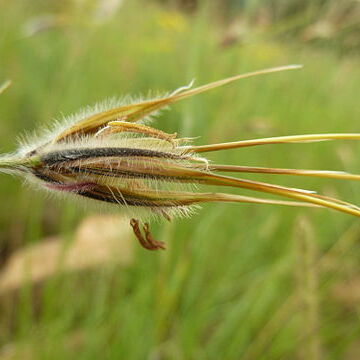Compactly tufted perennial; culms 30–120 cm. high; basal leaf-sheaths ± silky pubescent to fulvously tomentose.. Leaf-blades flat, 5–40 cm. long, 2–9 mm. wide, usually stiffly pubescent.. Panicle nodding, 7–20 mm. long, comprising 1–7 triads, each borne at the end of a slender flexuous branch; pedicels connate.. Spikelets narrowly lanceolate, 24–45 mm. long, pale yellow or yellowish brown, villous from rows of black tubercles; lower glume narrowly lanceolate, 3/4 as long as the spikelet; upper glume very narrowly lanceolate, almost as long as the spikelet, the lower lemma a little longer; upper lemma 9–14 mm. long, glabrous, acutely bilobed; awn 6–10 cm. long; callus 3 mm. long, pubescent.. Caryopsis hairy on top.
Tufted perennial 150-900 mm high; basal leaf sheaths silky pubescent to fulvously tomentose or covered with dense brown hairs; culm slender, 1 rarely 2-noded. Leaf blade 50-400 x 2-6 mm. Inflorescence of 1-7 triads, nodding; pedicels connate. Spikelet 24-45 mm long (excluding awn), narrowly lanceolate; glumes with many tubercle-based hairs, rarely hairs absent; lower glume 3/4 as long as spikelet, narrowly lanceolate, acuminate; upper glume almost as long as spikelet, very narrowly lanceolate; lower lemma with many tubercle-based hairs, rarely hairs absent; upper lemma glabrous or rarely obscurely hairy near apex, lobes awnless, acuminate to 3-5 mm long, central awn 50-100 mm long; anther 5-6 mm long.
Perennial; up to 0.9 m high; tufted. Leaf blades 50-400 x 2-6 mm; basal leaf sheaths covered with dense brown hairs at base. Flowers: in a compacted panicle; spikelets 24-45 mm long; pedicels connate; glumes and lower lemma with many tubercle-based hairs; rarely hairs absent; upper lemma glabrous or rarely obscurely hairy near apex; lobes not awned; acuminate up to 3-5 mm long; central awn 50-100 mm long.
Perennial, tufted, up to 0.9 m high. Leaf blades 50-400 mm long, 2-6 mm wide, basal leaf sheaths covered with dense brown hairs at base. Spikelets 24-45 mm long; pedicels connate; glumes and lower lemma with many tubercle-based hairs; female-fertile lemma side awns 3-5 mm long, central awns 50-100 mm long.
Superior lemma glabrous or rarely obscurely pubescent near apex, the lobes acute to acuminate, rarely prolonged into setae up to 3 mm, long, with a central awn 6–10 cm. long.
Perennial to 90 cm. Leaves linear, roughly hairy, basal leaf sheaths with dense brown hairs at base. Spikelets in threes, long-awned, glumes with tuberculate hairs.
Panicle 7–20 cm. long, linear, nodding, bearing 1–7 triads of spikelets with connate pedicels.
Spikelets 20–45 mm. long, yellow or yellowish brown, villous from rows of black tubercles.
Culms 30–120 cm. high, the basal sheaths silky pubescent to fulvously tomentose.
Inferior glume 3/4 length of spikelet.
Tufted perennial.

